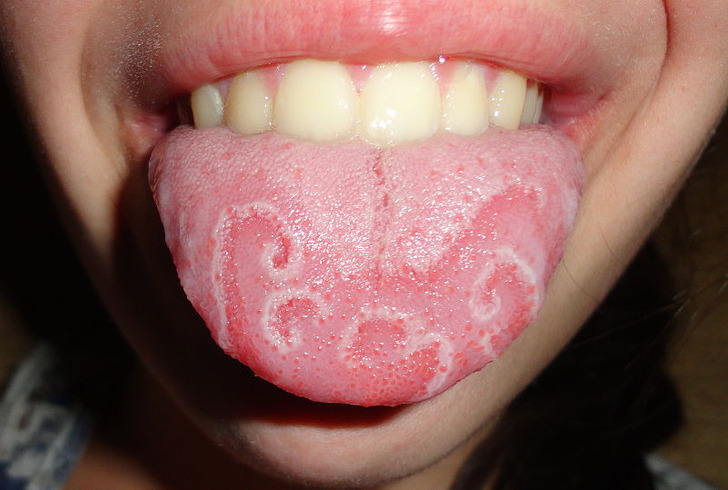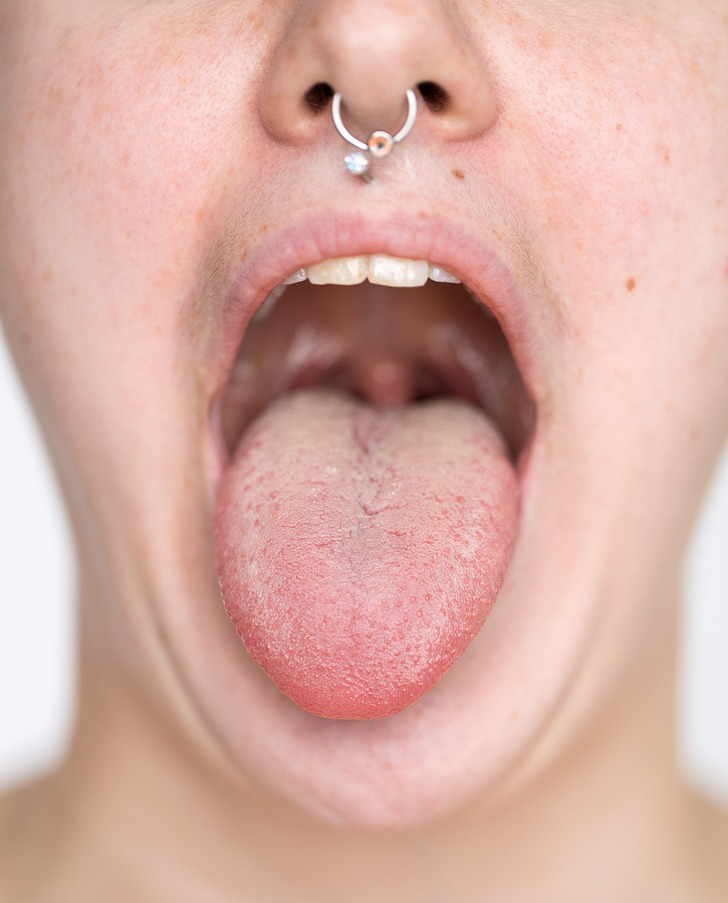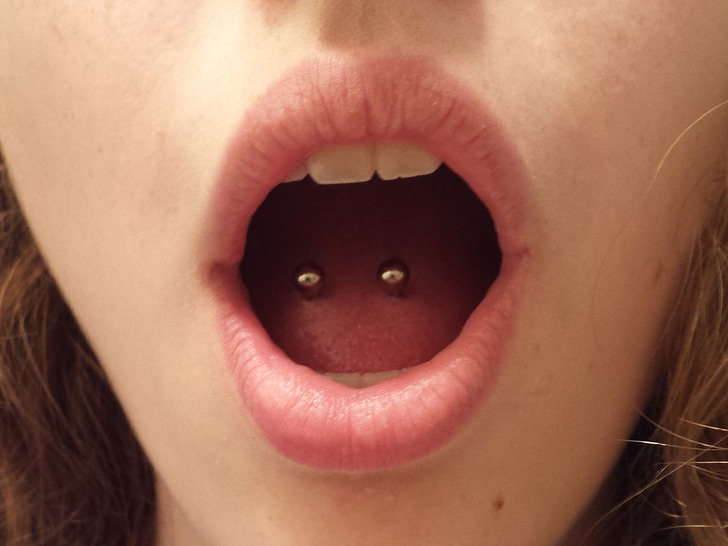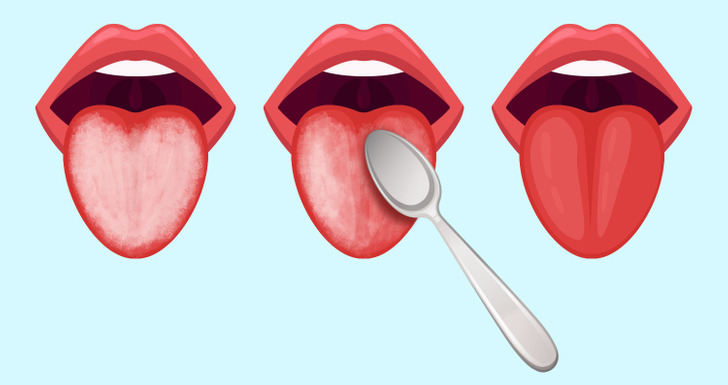There are many possible causes for white tongue, and in some cases, it comes with an unpleasant odor and mouth dryness. To get rid of it, sometimes you just need to brush your teeth. But what should you do if that doesn’t help?
❗ This article is for informative purposes only and can’t replace the advice of a specialist.
What white tongue is

The white film may cover the entire tongue, part of it, or appear as spots. At the same time, an unpleasant odor and taste in the mouth may appear. It looks as if there are small white hairs on the tongue’s surface. In fact, they are buds covered with organic particles, bacteria, and dead cells.
White plaque on the tongue (which can also be yellow) may appear for different reasons, like due to irritation or because of an infection. It usually disappears after several days. If the situation doesn’t change for several weeks, and it’s painful to eat and talk, it’s best to see a doctor.
It’s important to note that the plaque may not only be white. While a pink tongue is normal, a brown tongue means the person drinks too much coffee or tea. A yellow tongue means there’s something wrong with the liver, and a red tongue is a sign that the person lacks vitamin B.
Why the tongue becomes white

Usually, the tongue becomes white due to bacteria, leftover bits of food, or dead cells that get stuck in between the buds. Because of this, the buds may increase in size or become inflamed. This is how white spots on the tongue’s surface appear.
Sometimes, the plaque appears due to an illness. For example, the geographic tongue is also a condition where white spots appear on the tongue. It’s quite rare, and the causes are unknown, but the condition itself is often connected to eating foods that irritate the tongue. It may also be a reaction to stress, an illness, or hormonal changes.
Why white plaque appears on the tongue

There are some things that make the appearance of white plaque on the tongue more probable:
- Age
- Taking antibiotics (white-yellow plaque appearing when there’s a fungal infection in the mouth)
- A diet that’s lacking enough fruits, vegetables, vitamin B12, and iron
- A weak immune system
- Bad mouth hygiene
- Dental prosthetics or other objects that can damage the tongue
- Dehydration and mouth dryness
What piercings have to do with white tongue

Right after piercing the tongue, there might be some white film present. This happens because the number of bacteria on the tongue increases, and it’s normal. Antibacterial mouthwash will help you get rid of it. Plus, there might be a ring around the piercings, which is normal too, and it means the tissue is healing.
If the plaque appears due to an injury (including piercings), the healing should take around 1.5 weeks. You should avoid irritants, such as hot, spicy, or sour foods and drinks.
How to get rid of white tongue at home

- Practice good mouth hygiene.
- Drink enough water.
- Brush your teeth using a soft toothbrush.
- Use a mild fluoride toothpaste — one that doesn’t contain sodium lauryl sulfate.
- Use fluoride mouthwash.
- Brush your tongue or use a tongue scraper to remove the white coating.
- Drink cold drinks through a straw.
- Avoid food and drinks that are spicy, salty, acidic, or very hot in temperature.
Who to talk to if you’re worried about your white tongue

- Your dentist can help you remove the white film from the tongue and prescribe medications if needed.
- Your GP can diagnose the tongue, prescribe you certain medications and determine if the white tongue is an indicator of a more serious issue.
What do you do about white tongue?
Preview photo credit Genusfotografen (genusfotografen.se) & Wikimedia Sverige (wikimedia.se) / Wikimedia Commons, CC BY-SA 4.0, Martanopue / Wikimedia Commons, CC BY-SA 3.0
MY HUSBAND LEFT ME AND OUR KIDS FOR HIS MISTRESS – I WAS FURIOUS AND TOOK MY REVENGE.

The bitterness tasted like ash in my mouth. How could he? How could he just walk away, leaving us like discarded toys? Mark, my husband of fifteen years, the man I’d built a life with, had traded us in for a shiny, new model. A twenty-year-old, no less. A coworker. I’d suspected something was off, the late nights, the secretive phone calls, but I’d pushed it aside, trusting him. Foolish me.
The day I caught them, at that cheap motel on the outskirts of town, was seared into my memory. The look on his face, a mixture of guilt and something disturbingly close to relief, still haunted my dreams. He didn’t even try to deny it, just mumbled some pathetic excuse about “finding himself.”
The divorce was a whirlwind of lawyers and paperwork, a cold, clinical process that stripped away the remnants of our life together. He’d agreed to everything, too quickly, too easily. I was left with a pittance, barely enough to cover a few months’ rent.
Then came the real insult. He’d put our marital home, the house where we’d raised our kids, the house filled with memories, up for sale. And he’d listed it for an absurdly inflated price, far exceeding the online valuation used during the financial order. The judge had signed off on it, seemingly oblivious to the glaring discrepancy.
I was left scrambling, barely able to make ends meet, while he was raking in a fortune. Seeing that listing online, the photos of our home, now staged and impersonal, was like a knife to the heart. It was a constant reminder of everything I’d lost.
But the final straw was when his new fiancée, the mistress, announced on social media that they were buying a “dream home” because they were expecting a baby. A baby! He was building a new life, a new family, while my kids were struggling, while I was drowning in debt. The injustice of it all was suffocating.
I was consumed by rage, a burning desire for revenge. I wanted him to feel the same pain, the same despair, that he’d inflicted on me. I wanted him to understand the consequences of his actions.
It wasn’t until I visited my former mother-in-law, a woman who had always been kind to me, that a plan began to form. She was as devastated by Mark’s actions as I was. We sat in her cozy kitchen, sipping tea, and she told me stories of Mark’s childhood, of his father’s own infidelity, a pattern repeating itself.
Then, she mentioned a small, overlooked detail. A safety deposit box, inherited from Mark’s father, containing… well, she wasn’t entirely sure. She’d always assumed it was just old documents.
The next day, I went to the bank. I’d remembered Mark mentioning the box once, years ago, but he’d dismissed it as unimportant. I presented myself as his legal representative, using a power of attorney document I’d obtained during the divorce proceedings, a document Mark had signed without reading thoroughly.
Inside the box, nestled amongst faded photographs and yellowed letters, was a stock certificate. A substantial amount of shares in a company that had recently skyrocketed in value. Mark, in his haste to leave, had completely forgotten about it.
I sold the shares.
The money, a significant sum, allowed me to pay off my debts, secure a comfortable apartment for myself and the kids, and even put a down payment on a small business.
I didn’t tell Mark. I didn’t gloat. I simply moved on, building a new life for myself and my children. The satisfaction wasn’t in the money, but in the knowledge that I had taken back control, that I had turned his betrayal into my liberation. And maybe, just maybe, he’d learn that some things, like family, are worth more than any fleeting infatuation.



Leave a Reply